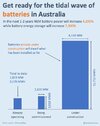Tesla building fast chargers now for trucks.
If Norwegian Ferries can charge 5MW in 5 minutes I don’t think there will be a future for swap batteries..
Where smart ferry charging begins with a smart grid
NORWAY: The Hareid-Sulesund ferry operations have reduced CO2 emissions by 7000 tonnes annually with the introduction of electric vessels. In transitioning ferries from diesel to pure electric power, powerful onshore support is essential, in the form of reliable infrastructure for rapid charging...www.danfoss.com
Electric trucks will come, they won't be Teslas.
Ferry Terminals are a few fixed place where they can have a high energy infrastructure.
Truck's your talking national grid.
Some of the towns don't have enough electricity capacity for charging a truck that fast.









